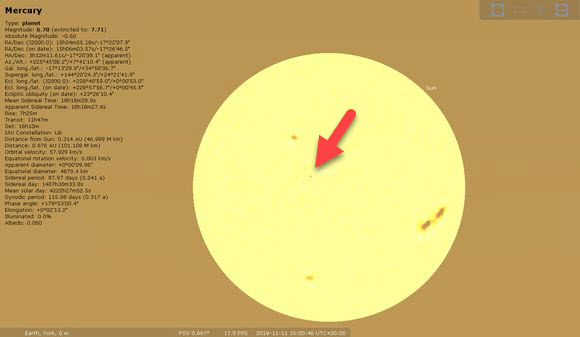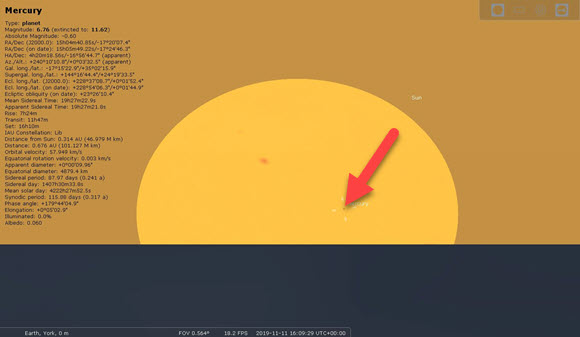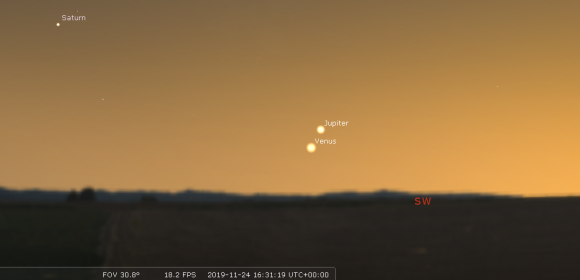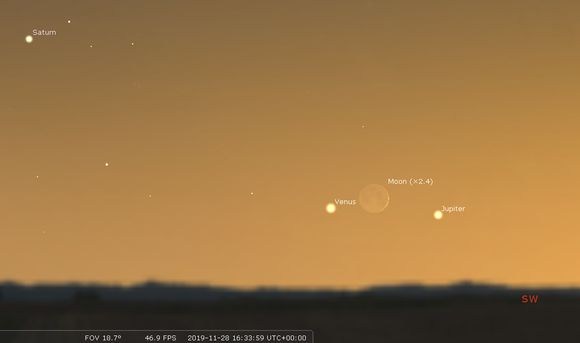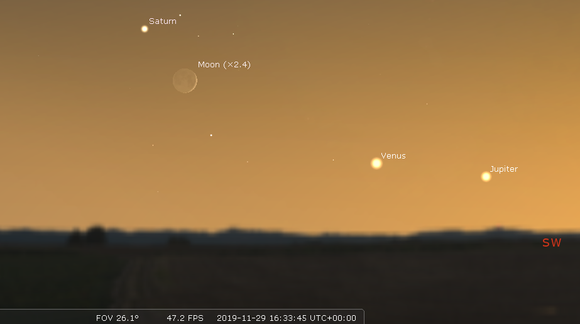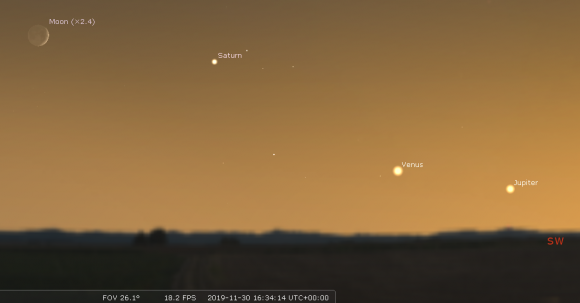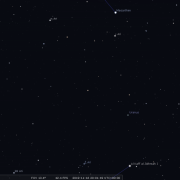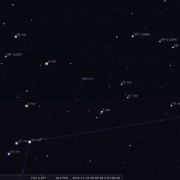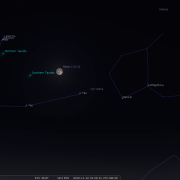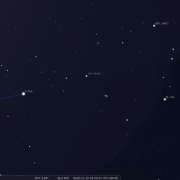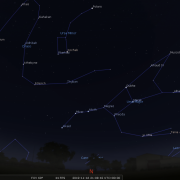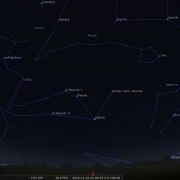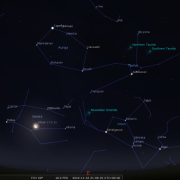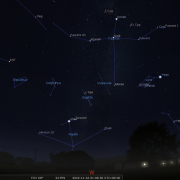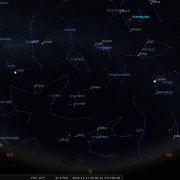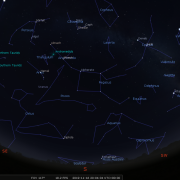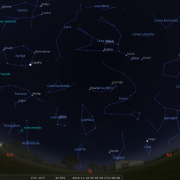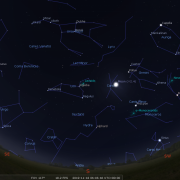In this month's Sky Notes:
Transit of Mercury
The undoubted highlight of the month is a transit of Mercury across the suns disk on Nov 11th. Being the innermost planet, transits of Mercury are more frequent than those of Venus, but are still not commonplace events.
Mercury is a small world and consequently resembles only a tiny black dot on the face of the sun. You will therefore require a telescope to observe it, but anything in excess of 30X magnification should suffice. The transit commences around 12:39h from this area, with mid transit occurring at 15:20h and finishing after 18:00h, however as the sun sets shortly after 16:00h, the latter part of the transit will not be visible.
And Now the Obligatory Solar Warning Message:
- Never look directly at the Sun with any optical aid (even your naked eye) without using suitable solar filters or solar viewing techniques.
- You may use neutral density or Mylar solar film, fashioned to fit over the objective end of your telescope (never the eyepiece).
- Alternatively you can try projecting the image of the sun onto a card, preferably in shade, so you can see the tiny black dot. Be careful using this method, do not be tempted to look through the finder scope (if fitted), blank it off or remove it. Align on the sun by aiming roughly in its direction and look for the smallest shadow of the telescope cast on the ground.
- Do not use any ‘screw on’ eyepiece solar filter sometimes supplied with cheaper scopes. Introduce such a filter to a hammer!
- If you require further advice please contact me by email. Further details will be given at the monthly meeting on the 5th.
Planetary Skylights
Evening Planets
This November sees a plethora of planetary conjunctions; indeed all five naked eye planets are visible, with Uranus and Neptune available for telescopic observation as well. Seven planets! Look down… that makes eight!
The downside is that all the naked eye planets are located around the margins; close to the horizon either just after sunset or shortly before sunrise and therefore not best placed for ‘meaningful scrutiny’. The upside is that given some clear skies, some great photo opportunities await.

 Jupiter continues to loiter just above the WSW horizon all month and has been joined by brilliant Venus. You will require a clear view of this aspect to appreciate the planetary fun and games, especially so during the last week of November when the pair are involved in some spectacular conjunctions.
Jupiter continues to loiter just above the WSW horizon all month and has been joined by brilliant Venus. You will require a clear view of this aspect to appreciate the planetary fun and games, especially so during the last week of November when the pair are involved in some spectacular conjunctions.
Observe as twilight descends, which by the end of the month is around 16:30h. You should easily spot both planets; Venus will be the more conspicuous, and a little lower. It is however slowly gaining in altitude and eventually will come to dominate the evening sky in the west.
The two planets are closest together on the 24th and 25th, but the spectacular conjunction is enhanced further when on the 28th a new crescent Moon emerges, gate crashing the party, before moving on to highlight Saturn the following evening.
 Saturn resides a little further round to the SW. If skies are clear, lighting conditions will afford an excellent opportunity for some photos. As visually attractive as the vista may look to the naked eye, telescopic views of the planets will be somewhat disappointing, the turbulent air making for unsteady seeing, although at the start of November Saturn will still be a viable target.
Saturn resides a little further round to the SW. If skies are clear, lighting conditions will afford an excellent opportunity for some photos. As visually attractive as the vista may look to the naked eye, telescopic views of the planets will be somewhat disappointing, the turbulent air making for unsteady seeing, although at the start of November Saturn will still be a viable target.
 Having reached opposition towards the end of last month, Uranus is well placed to track down and observe through a telescope. In fact keen sighted people observing from a dark location may be able to spot it with just the naked eye (assuming they know exactly where to look).
Having reached opposition towards the end of last month, Uranus is well placed to track down and observe through a telescope. In fact keen sighted people observing from a dark location may be able to spot it with just the naked eye (assuming they know exactly where to look).
Uranus resides just within the borders of Aries, but is some distance below the ‘crooked line’ asterism of the Ram. If you have a constellation chart or App etc, use Mesarthim and Iota Aries as pointers to locate Uranus, which resides three times the distance between these stars and a tad to the right, below them. Through binoculars Uranus resembles a rather faint star of subtle grey/green hue. You will require a telescope to discern its very small disk.
 Neptune resides in the constellation of Aquarius just under a degree lower right of the star phi aqr. You will require a telescope to spot its diminutive disk, which is fainter than all visible naked eye stars, but it does appear blue/grey in hue.
Neptune resides in the constellation of Aquarius just under a degree lower right of the star phi aqr. You will require a telescope to spot its diminutive disk, which is fainter than all visible naked eye stars, but it does appear blue/grey in hue.
Morning Planets
The November dawn also harbours a planet or two, with Mars and eventually Mercury both visible to the naked eye. A clear view of the ESE horizon is essential, especially from the 23rd onwards observing from around 06:30h.

 Look for elusive Mercury climbing above the horizon up to ten degrees and joining amber hued Mars located to the upper right. At this stage Mars will be brighter of the two, although not by much. Mercury brightens as it moves through its apparition, so that it will appear the dominant planet by late November/early December. It will continue to brighten, but will then be sinking back down into the glare near the horizon before sunrise and therefore more difficult to spot. The optimum period will be during the last week of November. View on the 24 and 25th when a very slim waning crescent Moon resides above Mars, and then to the left of Mercury. Mercury reaches greatest elongation from the sun on November 28th. Use binoculars if you are having difficulty spotting Mercury initially.
Look for elusive Mercury climbing above the horizon up to ten degrees and joining amber hued Mars located to the upper right. At this stage Mars will be brighter of the two, although not by much. Mercury brightens as it moves through its apparition, so that it will appear the dominant planet by late November/early December. It will continue to brighten, but will then be sinking back down into the glare near the horizon before sunrise and therefore more difficult to spot. The optimum period will be during the last week of November. View on the 24 and 25th when a very slim waning crescent Moon resides above Mars, and then to the left of Mercury. Mercury reaches greatest elongation from the sun on November 28th. Use binoculars if you are having difficulty spotting Mercury initially.
 Mars continues to pull slowly away from the ESE horizon. At Mag +1.5 it is not overly bright, but is decidedly orange in hue. From the 9th-11th Mars overtakes the bright star Spica – so do not confuse the two.
Mars continues to pull slowly away from the ESE horizon. At Mag +1.5 it is not overly bright, but is decidedly orange in hue. From the 9th-11th Mars overtakes the bright star Spica – so do not confuse the two.
 If you fancy trying to spot a minor planet, Vesta comes to opposition on the 12th and will be visible all night. At the start of the month it resides in Taurus near the border with Cetus. On the 4th,5th and 6th it passes just below the star omicron Tauri. This may be the optimum period to track Vesta down as it close to omicron and distant from moonlight. By the 12th the Full moon will be in the vicinity and Vesta will have moved over the border into Cetus, though still just a degree to the right of Omicron Tauri. At Mag + 6.5 Vesta is borderline naked eye, however binoculars will show it easily and its identity will be betrayed by its fairly rapid motion over consecutive nights.
If you fancy trying to spot a minor planet, Vesta comes to opposition on the 12th and will be visible all night. At the start of the month it resides in Taurus near the border with Cetus. On the 4th,5th and 6th it passes just below the star omicron Tauri. This may be the optimum period to track Vesta down as it close to omicron and distant from moonlight. By the 12th the Full moon will be in the vicinity and Vesta will have moved over the border into Cetus, though still just a degree to the right of Omicron Tauri. At Mag + 6.5 Vesta is borderline naked eye, however binoculars will show it easily and its identity will be betrayed by its fairly rapid motion over consecutive nights.
05 and 12-Nov-2019 at 19:30h (general SE direction). Dwarf Planet Vesta
Location Charts. (Click for full-sized images)
Meteors

- The Leonids are active from 15-20th Nov with the 2019 peak over the night of the 18th. A last quarter moon will also be visible in the sky, so observed numbers will be diminished by moonlight. For most years Leonid rates are around 25 per hour, rising to 100s if not 1,000s during ‘storm’ years, which occur at intervals of roughly 33 years, coinciding with the return of the periodic parent comet Temple Tuttle. The next storm years are expected sometime after 2030. With the unfavourable conditions this year (moonlight) expect to witness around a dozen per hour in the early morning hours. Leo rises late in the evening.
- South Taurids (04 to 05-Nov): Also during November keep an eye out for a few meteors on the night of Nov 4/5th when the South Taurid meteor shower reaches a peak
- North Taurids (11/12-Nov): Then look again on the night of Nov 11/12th when the North Taurid meteor shower peaks. The hourly rate is low; only around 5 meteors, but although few, Taurids can produce a few fireballs! The Taurids are an old shower, associated with the periodic Comet Enke. Over time dust from this comet has been depleted and spread out over a broad swath of the inner solar system, giving rise to Taurid meteor showers not only on Earth but also on Mars and Venus.
November 2019 Sky Charts
|
Looking North
Mid-November - 21:00h |
Looking South |
|
Looking East
Mid-November - 21:00h |
Looking West
Mid-November - 21:00h |
|
Northern Aspect
Mid-November - 20:00h |
Southern Aspect
Mid-November - 20:00h |
| Looking North (Early) Mid-November - 06:00h |
Looking South (Early) Mid-November - 06:00h |
Additional Image Credits:
- Planets and Comets where not otherwise mentioned: NASA
- Sky Charts: Stellarium Software
- Log in to post comments


